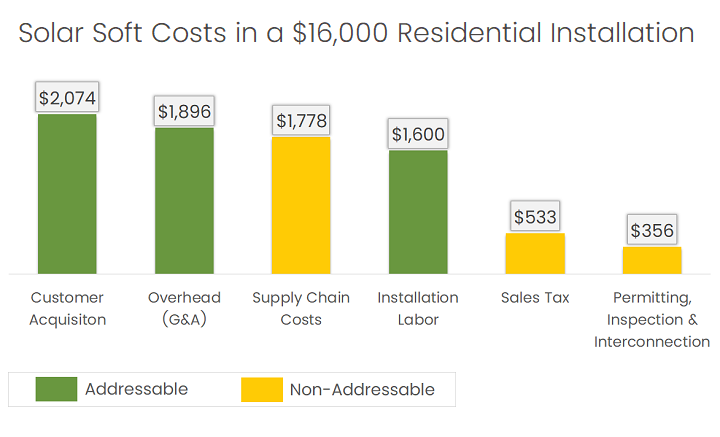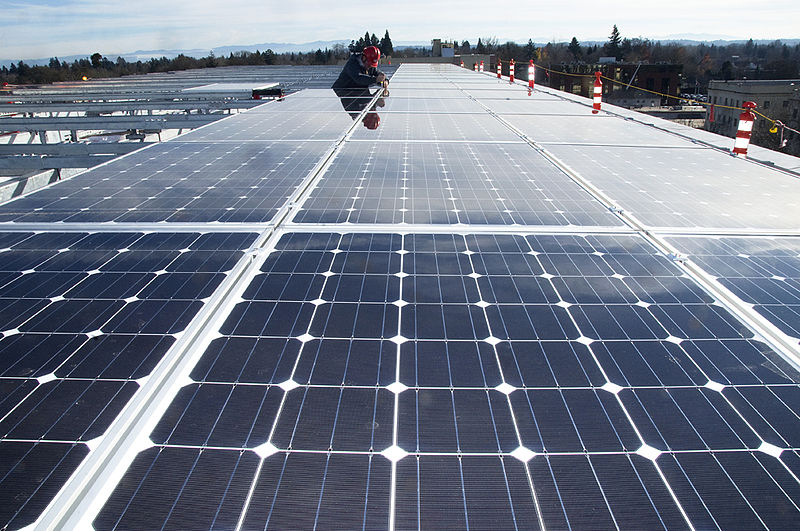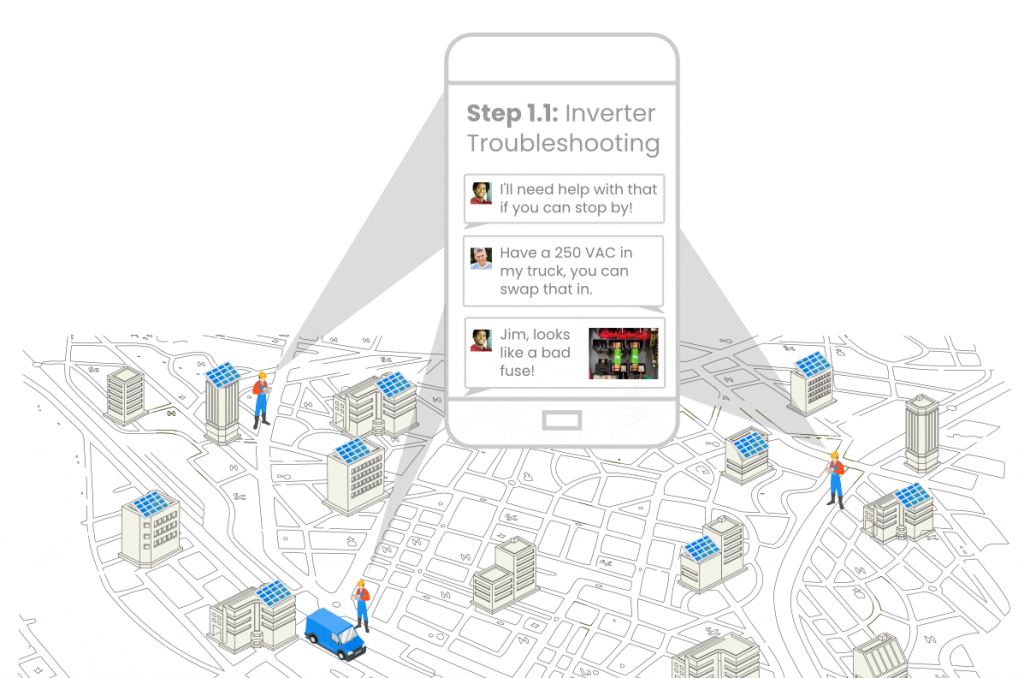Whether you manage a local rooftop PV installation business or a nationwide solar operation, solar soft costs are one of the most talked about and critical challenges for solar managers to tackle right now. In this post, we’ll give you a firm foundation for what solar soft costs entail and how to start addressing soft cost inefficiencies at work. In this guide, we will go over these key questions:
- What Are Solar Soft Costs?
- How Do Soft Costs Impact Me?
- How Do I Take Action on Soft Costs?
1. What Are Solar Soft Costs?
Simply put, solar soft costs are made up of all the customer acquisition, personnel, administrative and operational expenses outside of the solar panels, inverters and other balance of system hardware components required to sell and install a PV system.
- The US solar market continues to show tremendous growth, passing 2 million installations in 2019 and forecast to hit 3 million in 2021. This is partially fueled by a continued fall in the cost of solar panels.
- The total cost of residential PV systems has fallen by over 65% in the last 10 years, but most of this is attributable to the fall in hardware costs. This means that soft costs as a share of total system cost has actually risen.
- Today, as much as 65% of a new solar system’s overall cost can be attributed to soft costs.

For solar contractors, this is a warning sign that they cannot continue to rely solely on decreasing component prices as a viable means to grow and maintain profits. In order to build a sustainable solar company, both solar and non-solar research shows that targeting soft cost reductions is now the fastest and most effective way to get there.
The Solar Energy Industries Association highlights permitting and inspection costs as primary drivers of solar project soft costs, and has called for government action to reduce them. But in the meantime, this makes it all the more critical that solar managers tackle the soft cost drivers that are within their immediate control.
2. How Do Soft Costs Impact Me?
One of the key responsibilities of solar business managers is to steer company operations so as to maximize profit margins. In rapidly growing sectors, managers typically have focused on increasing top-line revenue through growth and market penetration. However, as the solar market matures, it’s crucial to keep an eye on the bottom line in order to be a truly efficient and growth-ready company.
On an typical residential installation costing $16,000, up to $5,500 of that are soft costs that are within the solar company’s span of control, according to NREL’s research model estimates. Obviously there will always be overhead costs needed to drive the company’s critical business functions. But every dollar the company can save in soft costs contributes to the bottom line.
Solar companies have significant soft cost savings in front of them when it comes to solar installation labor, and G&A overhead. Most of this is in the low value, unnecessary work that your employees find frustrating. So you’ll find your team is spending more time at what they’re good at, and probably finding their work more satisfying.

In our experience, US solar companies can reduce their soft costs by over $1100 and boost net profits by 60%, by focusing on the three problem areas of repeat site visits, manual data entry and formatting, and data collection costs.
No two solar providers have the same processes, but a common consensus is that teams—unfortunately—spend more time on repetitive, manual and administrative tasks than on growing the business itself. To give you and your team back some of that time, the easiest way to automate those small, annoying steps.
3. How Do I Take Action on Soft Costs?
In order to minimize your overhead, your focus will need to be on streamlining the processes behind activities like customer acquisition, labor management, and supply chain.
Select an operational process that you are familiar with (installation, inspection, maintenance, etc.) and ask yourself:
- Is this being done in the most efficient way possible?
- Where are the bottlenecks?
- How much time is the team wasting because of ineffective communication channels?
- What proportion of their time is spent doing administrative tasks versus work that directly contributes to growing my company?
- How much of my team’s time is spent reporting to someone or waiting for a response?
- How different is the current process compared to my ideal version of how it should be run?
What you’ll likely find is that there is a compounding effect taking place: small delays, missed steps or communication inefficiencies conspire to become large, costly time-wasters for you and your team. What can you do about them?

Over the past few years, the US solar industry has embraced the idea of implementing innovative technology to spur growth. For many commercial and residential customers, the decision to invest in a solar and storage system has historically been a financial one, but for an increasing number of people, going solar is an emotional choice.
Today there is software that supports multiple solar business processes, from digitizing the proposal design process to empowering better data collection and retrieval in the field. In most cases, solar companies choose and implement a handful of best-in-class solutions so they can optimize specific key business functions.
Mobile work process management & automation software (mPMA) focuses on addressing the operational challenges of solar installation, maintenance, sales and management teams. Your mPMA platform allows you to cut return site visits, data collection costs, and manual report formatting.
If your company does not have a CTO or CIO with a process for exploring new technologies in place, we recommend starting by:
- Researching the different technology solutions available
To get a lay of the land, ask for referrals from your network, read case studies put out by different software platforms and look up companies who attend or are affiliated with major solar events. Software review and directory sites may have relevant product reviews if you search for the word “solar” specifically. - Requesting consultations and trials
Demos are great, but if the software company is not willing to work with you to ensure that the solution fits your problems, then that could be a red flag. Solar software should have some flexibility, especially as the market for it is quite new. - Focusing on getting buy-in from one side of operations
If you have a focus area and have discussed pain points with the key people involved, it gives you a much clearer set of criteria when sourcing solar software. Start with one team (e.g. residential installation only) to try the tool before rolling it out to other departments.

Though it does take an open-minded and results-oriented leader to step outside of traditional methods and embrace innovation, the results are well worth it. You can then further stabilize solar operations by reinvesting the money that is saved into increasing innovation, quality and customer experience to form a solid foundation for future growth.
What’s important to note is that the pursuit of solar soft cost reduction has long-lasting and far-reaching effects on your organization that go beyond increasing profits; it results in cultivating a solar company that is more resilient, more disciplined and possesses a solid foundation for growth.
Interested in seeing what a reduction in soft costs can do for your company? Try one of the pre-configured best practice apps from the Solar App Store today. Companies like SunSystem Technologies and have captured annualized savings of over $17,000 per employee.
Originally published June 1st, 2017; republished April 2, 2022 with updated data.


